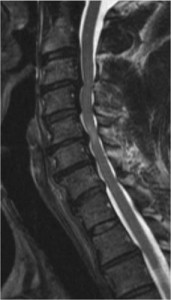Cervical Spinal Stenosis
Stenosis is a term used to describe a narrowing of various parts of the body. Cervical spinal stenosis is a degenerative disease where the spinal canal and neural foramina (tunnels where nerves leave the spinal canal) narrow and compress the spinal cord and nerve roots. The facet joints are overlapping arches that form the spinal canal. These joints are covered with cartilage. Degenerative changes can cause the facet joints to inflame and enlarge, thus causing stenosis of the spinal canal. This disorder is most common in middle aged patients and beyond. However, congenital factors may predispose a person for stenosis at an earlier age.
The symptoms of cervical stenosis are very similar to that of disc herniation, except that disc herniation is an acute event, while stenosis is a chronic, slowly progressive process. Patients who have severe cervical stenosis may suffer from a shooting pain that can feel a bit like an electric shock, especially when they bend their neck forwards. Spinal stenosis may also cause numbness, weakness, burning sensations, and tingling in the extremity.

Unrecognized nerve problems with spinal cord compression are sometimes seen and may not necessarily involve a lot of pain. People may begin to notice they’re walking funny, have difficulty walking, notice subtle changes in their bowel, bladder or sexual functions, may complain of neck pain, some occasional arm or shoulder pain, and some clumsiness in the fingers. But these are things that people may not always necessarily refer to some problem in the neck, and so it’s really not uncommon that these severe cases of spinal cord compression in the neck go unrecognized for a long period of time or misdiagnosed as some other problem. These are symptoms that both patients and family physicians should be aware of.
Cervical stenosis is suspected when patients have characteristic symptoms and there is evidence on x-rays that there is not enough space available for the spinal cord. A physician may use MRI to determine whether or not the spinal cord is narrowed and the degree of the compression (Figure 6).
Conservative or non surgical treatment can be tried for the milder cases, and the patients are closely observed for response to the treatment. In non responsive cases, surgery involving removal of the obstruction that caused the symptoms usually gives patients some relief.
Spinal stenosis is a common cause of neck pain. Learn more about the symptoms of Neck Pain, Non-surgical Treatment and Surgical Treatment for Neck Pain.
For a comprehensive consultation of your neck problems, contact us to make an appointment with us. Visit Pinnacle Spine & Scoliosis Centre here.
Looking For A Reliable Back Orthopaedic Specialist?
Fast Medical Attention, Transparent Fees
Make an appointment for comprehensive care for your back problems!
